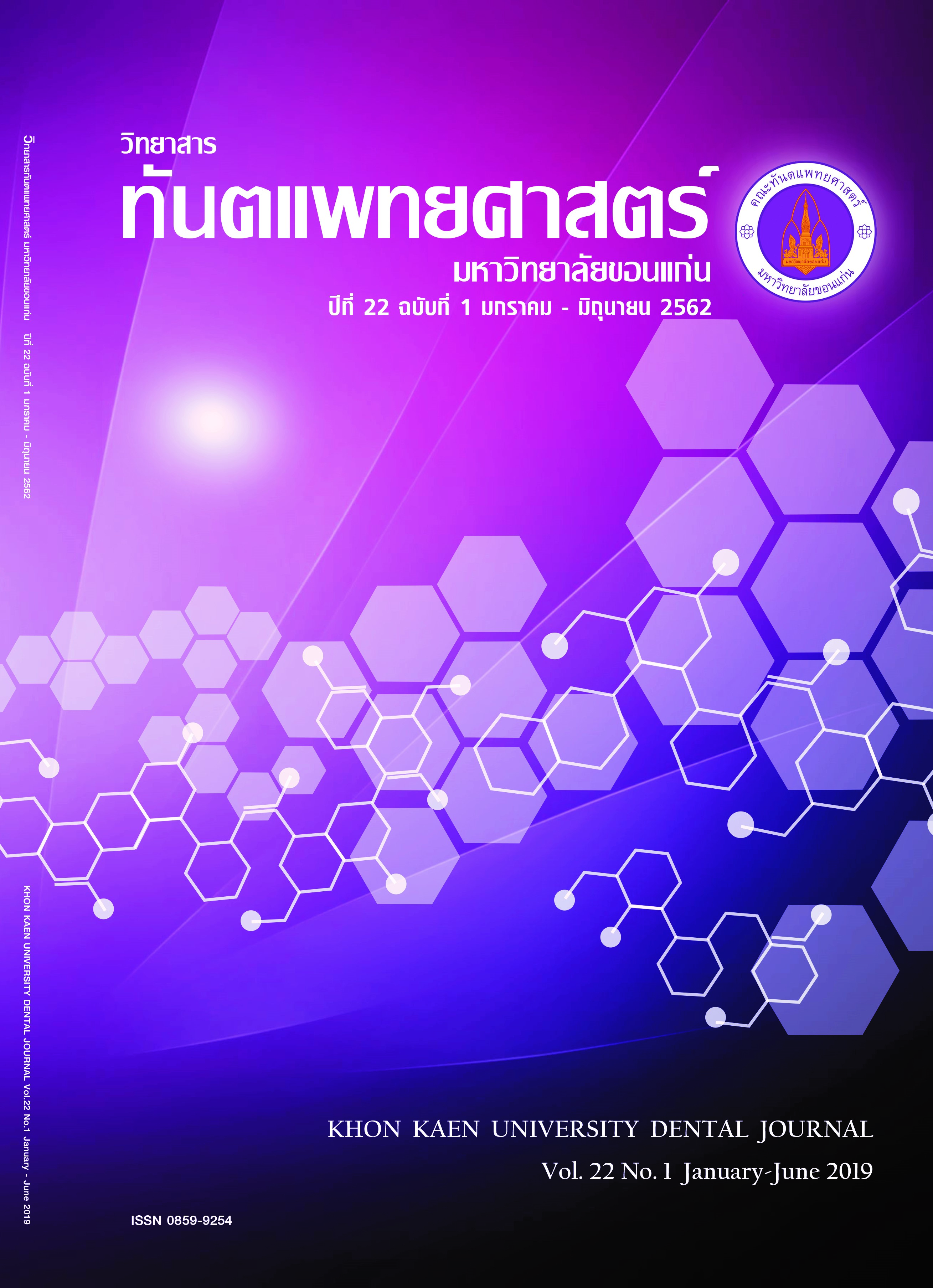An in vitro Comparison of Dentin pH Changes Following Canal Dressing Among Calcium Hydroxide Paste in Combination with Normal Saline and A Commercial Calcium Hydroxide Paste
Main Article Content
Abstract
The objective of this in vitro study was to compare dentin pH following canal dressing. Using 45 extracted human lower premolar teeth. The teeth were randomly divided into 2 experimental groups: Group 1 - calcium hydroxide-normal saline solution paste; Group 2 - commercial calcium hydroxide paste (Endocal®); Group 3 - and 1 control group, in which there was no application of the intracanal medication (15 teeth per group). The dentin pH in the solution was measured 0, 1, 7, 14, 21 and 28 days after canal dressing to determine the diffusion of hydroxide ion through the dentinal tubules. The result found that the dentin pH for each group at the same time. The group of commercial calcium hydroxide paste (Endocal®) had a highest dentin pH and the difference was statistically significant (P-value < 0.05) from other groups on the first day of medication. However, no significant difference was found among the dentin pH at 1, 7, 14, 21 and 28 days after canal dressing between calcium hydroxide-normal saline solution paste group and commercial calcium hydroxide paste (Endocal®). Therefore, the use of commercial calcium hydroxide paste (Endocal®) for Microbial microbe reduction is recommended. When fast-acting intracanal Medication is needed. However, both calcium hydroxide-normal saline solution and commercial calcium hydroxide paste (Endocal®) could be used for long term medication of less than 28 days.
Article Details
บทความ ข้อมูล เนื้อหา รูปภาพ ฯลฯ ที่ได้รับการลงตีพิมพ์ในวิทยาสารทันตแพทยศาสตร์ มหาวิทยาลัยขอนแก่นถือเป็นลิขสิทธิ์เฉพาะของคณะทันตแพทยศาสตร์ มหาวิทยาลัยขอนแก่น หากบุคคลหรือหน่วยงานใดต้องการนำทั้งหมดหรือส่วนหนึ่งส่วนใดไปเผยแพร่ต่อหรือเพื่อกระทำการใด ๆ จะต้องได้รับอนุญาตเป็นลายลักษณ์อักษร จากคณะทันตแพทยศาสตร์ มหาวิทยาลัยขอนแก่นก่อนเท่านั้น
References
2. Perez F, Calas P, Rochd T. Effect of dentin treatment on in vitro root tubule bacterial invasion. Oral Sur Oral Med Oral Pathol Oral Radio Endod 1996;82:446-51.
3. Bystrom A, Sundqvist G. The antibacterial action of sodium hypochlorite and EDTA in 60 cases of endodontic therapy. Int Endod J 1985;18(1):35-40.
4. Gomes BP, Lilley JD, Drucker DB. Variations in the susceptibilities of components of the endodontic microflora to biomechanical procedures. Int Endod J 1996;29(4):235-41.
5. Hermann B. Calciumhydroxyd als mittel zurn behandel und füllen vonxahnwurzelkanälen: Thesis] Würzburg; 1920.
6. Siqueira JF, Jr. Strategies to treat infected root canals. J Calif Dent Assoc 2001;29:825-37.
7. Fava LR, Saunders WP. Calcium hydroxide pastes: classification and clinical indications. Int Endod J 1999; 32(4):257-82.
8. Siqueira JF, Jr., Lopes HP. Mechanisms of antimicrobial activity of calcium hydroxide: a critical review. Int Endod J 1999;32(5):361-9.
9. Mohammadi Z, Dummer PM. Properties and applications of calcium hydroxide in endodontics and dental traumatology. Int Endod J 2011;44(8):697-730.
10. Simon ST, Bhat KS, Francis R. Effect of four vehicles on the pH of calcium hydroxide and the release of calcium ion. Oral Sur Oral Med Oral Pathol Oral Radio Endod 1995;80(4):459-64.
11. Nerwich A, Figdor D, Messer HH. pH changes in root dentin over a 4-week period following root canal dressing with calcium hydroxide. J Endod 1993;19(6):302-6.
12. Wang JD, Hume WR. Diffusion of hydrogen ion and hydroxyl ion from various sources through dentine. Int Endod J 1988; 21(1):17-26.
13. Fuss Z, Szajkis S, Tagger M. Tubular permeability to calcium hydroxide and to bleaching agents. J Endod 1989;15(8):362-4.
14. Estrela C, Pimenta FC, Ito IY, Bammann LL. Antimicrobial evaluation of calcium hydroxide in infected dentinal tubules. J Endod 1999;25(6):416–8.
15. Misra P, Bains R, Loomba K, Singh A, Sharma VP, Murthy RC, Kumar R. Measurement of pH and calcium ions release from different calcium hydroxide pastes at different intervals of time: Atomic spectrophotometric analysis. J Oral Biol Craniofac Res 2017;7(1):36-41.
16. Wang JD, Hume WR. Diffusion of hydrogen ion and hydroxyl ion from various sources through dentine. Int Endod J 1988;21(1):17-26.
17. Carrigan PJ, Morse DR, Furst L, Sinai IH. A scanning electron microscopic evaluation of human dentinal tubules according to age and location. J Endod 1984;10(8):359-363.
18. Pérez F, Franchi M, Péli JF. Effect of calcium hydroxide form and placement on root dentin pH. Int Endod J 2001;34:417-23.
19. Sutimuntanakul S, Srisumran C. The pH changes of root dentin when dressing with calcium hydroxide. Mahidol dental journal 2010;30(2):81-90.
20. Pacios MG et al. Influence of different vehicles on the pH of calcium hydroxide pastes. J Oral Sci 2004;46(2):107-11.


